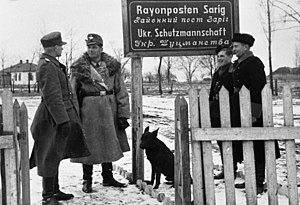| Schutzmannschaft | |
|---|---|
 German Order Police officer visiting the Ukrainian Schutzmannschaft unit in Zarig near Kiev, December 1942 | |
| Active | Founded in July 1941 by Heinrich Himmler |
| Country | German-occupied Eastern Europe |
| Allegiance | Ordnungspolizei |
| Branch | Schutzstaffel |
| Type | Auxiliary police |
| Size | 300,000 |
The Schutzmannschaft, or Auxiliary Police (lit. "protection team"; plural: Schutzmannschaften,[nb 1] abbreviated as Schuma) was the collaborationist auxiliary police of native policemen serving in those areas of the Soviet Union and the Baltic states occupied by Nazi Germany during World War II. Heinrich Himmler, head of the Schutzstaffel (SS), established the Schutzmannschaft on 25 July 1941, and subordinated it to the Order Police (Ordnungspolizei; Orpo).[2] By the end of 1941, some 45,000 men served in Schutzmannschaft units, about half of them in the battalions.[3] During 1942, Schutzmannschaften expanded to an estimated 300,000 men, with battalions accounting for about a third, or less than one half of the local force.[4][5] Everywhere, local police far outnumbered the equivalent German personnel several times; in most places, the ratio of Germans to natives was about 1-to-10.[6]
The auxiliary police battalions (Schutzmannschaft-Bataillone) were created to provide security in the occupied territories, in particular by combating the anti-Nazi resistance. Many of these battalions participated in the Holocaust and caused thousands of Jewish deaths. Usually the battalions were voluntary units and were not directly involved in combat. In total, about 200 battalions were formed.[7] There were approximately 21 ethnic Estonian,[nb 2][8] 47 Latvian,[9] 26 Lithuanian,[nb 3][11] 11 Belarusian,[12] 8 Tatar,[12] and 71 Ukrainian[13] Schuma battalions. Each battalion had an authorized strength of about 500, but the actual size varied greatly. They should not be confused with native German Order Police battalions (SS-Polizei-Bataillone) which the Order Police formed between 1939 and 1945 and which also participated in the Holocaust.[14]
The Order Police organized the Schutzmannschaften by nationality: Belarusian, Estonian, Latvian, Lithuanian, and Ukrainian.[15]
- ^ Brandon & Lower 2008, p. 268.
- ^ Schiessl 2009, p. 39.
- ^ Breitman 1990.
- ^ Dean 2003, p. 60.
- ^ Arad 2009, pp. 107–108.
- ^ Browning 2002, p. 257.
- ^ Stankeras 2008, p. 459.
- ^ a b Jurado & Thomas 2012, p. 12.
- ^ Jurado & Thomas 2012, p. 20.
- ^ Bubnys 1991.
- ^ Jurado & Thomas 2012, p. 36.
- ^ a b Abbott 1983, pp. 15–16.
- ^ Abbott & Pinak 2012, p. 38.
- ^ Goldhagen 2007, pp. 181–282.
- ^ Dean 2003, p. 69.
Cite error: There are <ref group=nb> tags on this page, but the references will not show without a {{reflist|group=nb}} template (see the help page).